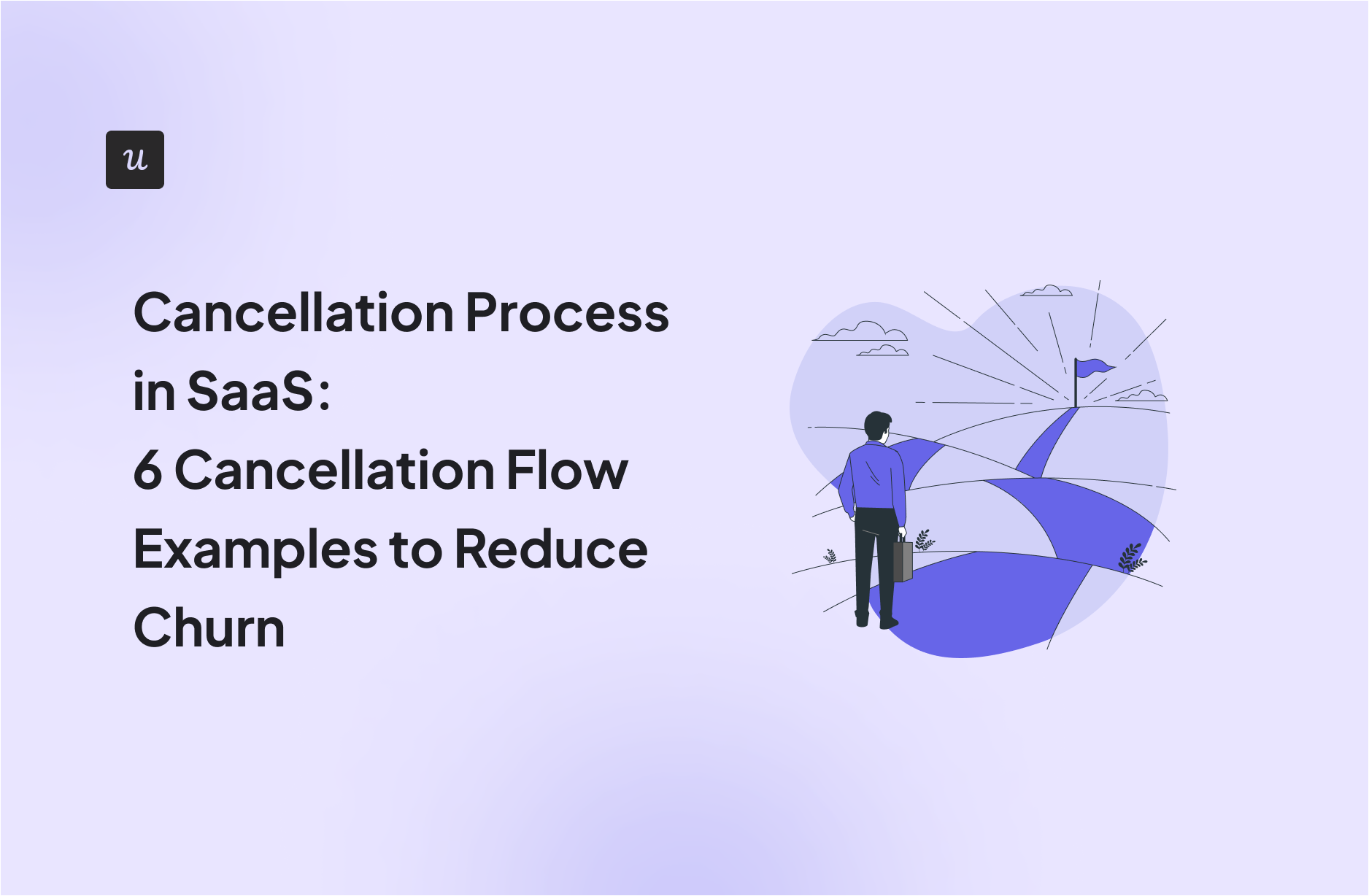
Cancellation Process in SaaS: 6 Cancellation Flow Examples to Reduce Churn
If you’re looking for the best cancellation flow examples for SaaS, you’re in the right place.
While it’s normal for some users to unsubscribe, you shouldn’t just let it happen without doing something about it.
And I’m not talking about making canceling their subscription impossible.
I’m referring to creating a process for subscription businesses that promotes customer retention by providing them with options and incentives designed to keep their subscription.
This post discusses the following:
- What a cancellation flow is and why it’s important.
- Examples of the best SaaS cancel flow sessions for inspiration.
- How to quickly develop and implement a SaaS cancellation flow to retain customers.
Get The Insights!
The fastest way to learn about Product Growth, Management & Trends.
Cancellation flow summary
- A cancellation flow reduces customer churn by offering users alternatives that make keeping their accounts more feasible.
- At the very least, cancellation flow helps you gather customer data that you can use to proactively reduce churn and improve customer retention.
- Your cancellation process should increase the possibility that previous customers will use your services again.
- Your cancellation flow must give customers complete control over deciding whether to unsubscribe or not.
- Find why customers want to unsubscribe using an exit survey during a cancellation request with multiple-choice questions.
- Limit your survey to the fewest questions possible so you can collect more answers.
- Make personalized offers to customers planning to cancel based on their current plan and usage.
- Build a cancellation flow with Userpilot without having to code in three simple steps: build a modal with a micro survey, build custom user segments using the data collected, and offer personalized alternatives to canceling. Automate your cancellation flow! Get a Userpilot demo to see how.
What is a cancellation flow?
A cancellation flow is a series of steps a user must take when canceling a product or subscription service.
Often referred to as exit surveys or churn surveys, a flow is not just a simple survey. It also includes offering alternatives during the offboarding process and collecting and using the data to improve customer experience in the long run and proactively retaining customers in the future.
Why should you implement a cancellation flow?
Cancellation flow is critical to the success of your SaaS business, and below are ways how it can help:
A cancellation flow helps retain existing customers
Cancellation flows aim to keep customers from canceling and reduce customer churn rates. But it’s done so that customers have complete control over their decisions.
By forcing them to keep their subscription, you remove their freedom to choose what’s best for them.
If that’s the case, you’ll piss off all your customers—even your most loyal ones—causing each one of them to opt out of your services.
So, the best you can do with a cancellation flow is to remind them of the real value of your product or service’s value and offer an alternative solution to get back in their good graces.
A cancellation process helps collect valuable feedback
Believe it or not, a customer canceling their subscription to your SaaS is not the worst thing that could happen.
Losing a customer because it’s simply not working out is better than forcing one who doesn’t want to use your services in the first place.
But before they unsubscribe, ask questions about their decision using churn surveys.
Your customer success team can then use customer feedback data to improve your product and service and prevent future churn.
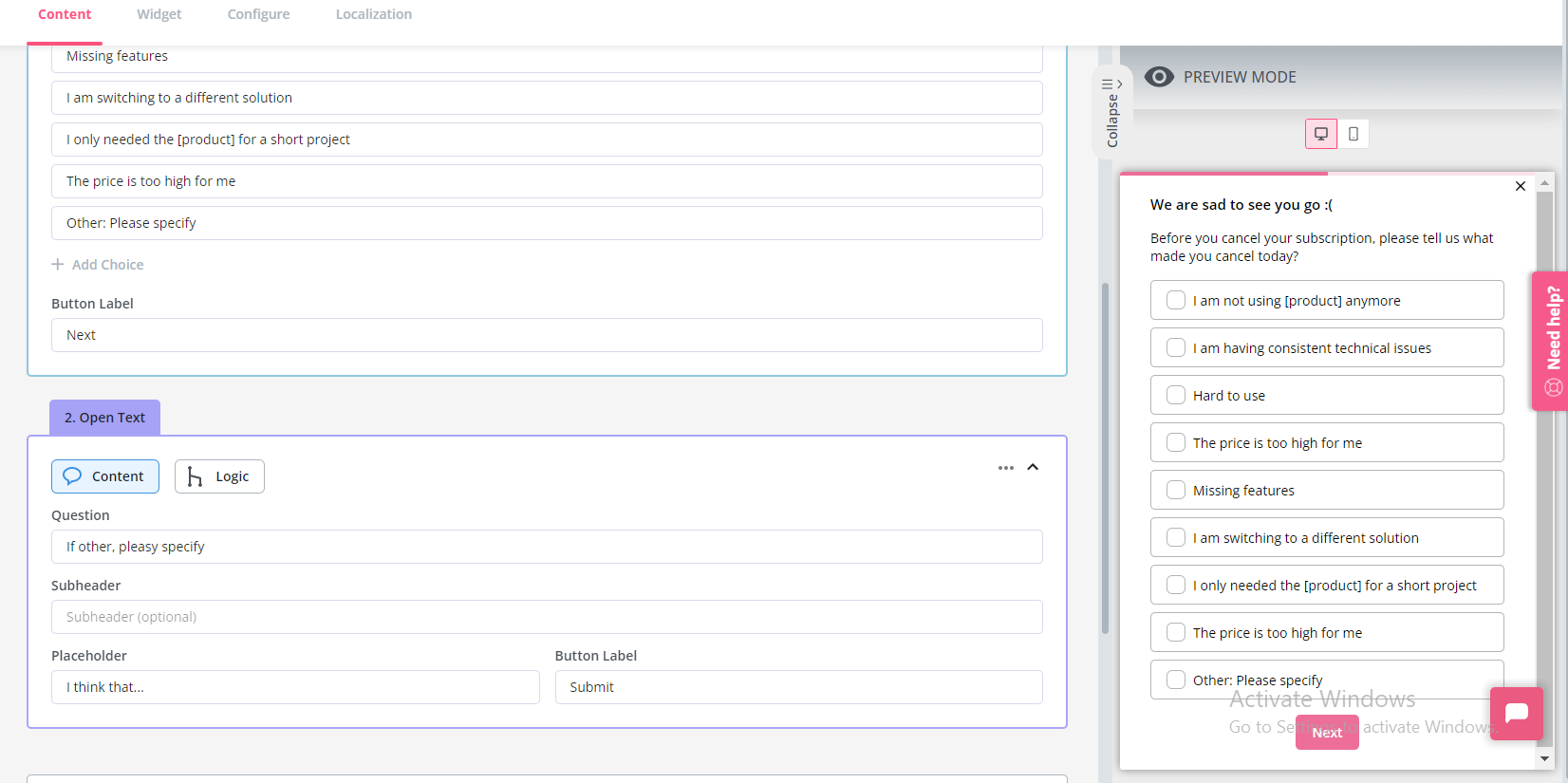
For instance, you can unearth insights regarding features or functionalities in your service that are half-baked or missing. From here, you can find ways to improve existing features or include new ones in the product.
Cancelation flows leave the door open to re-engage churned users
Just because customers canceled their subscriptions doesn’t mean they won’t come back in the future.
Cancellation flows let you give people a proper send-off and appreciate their time with you as customers.
From here, your show of class will pave the way for their eventual return months or years from now.
Also, you can take a more proactive approach by using the reasons why they left your business to re-engage and get them to re-subscribe.
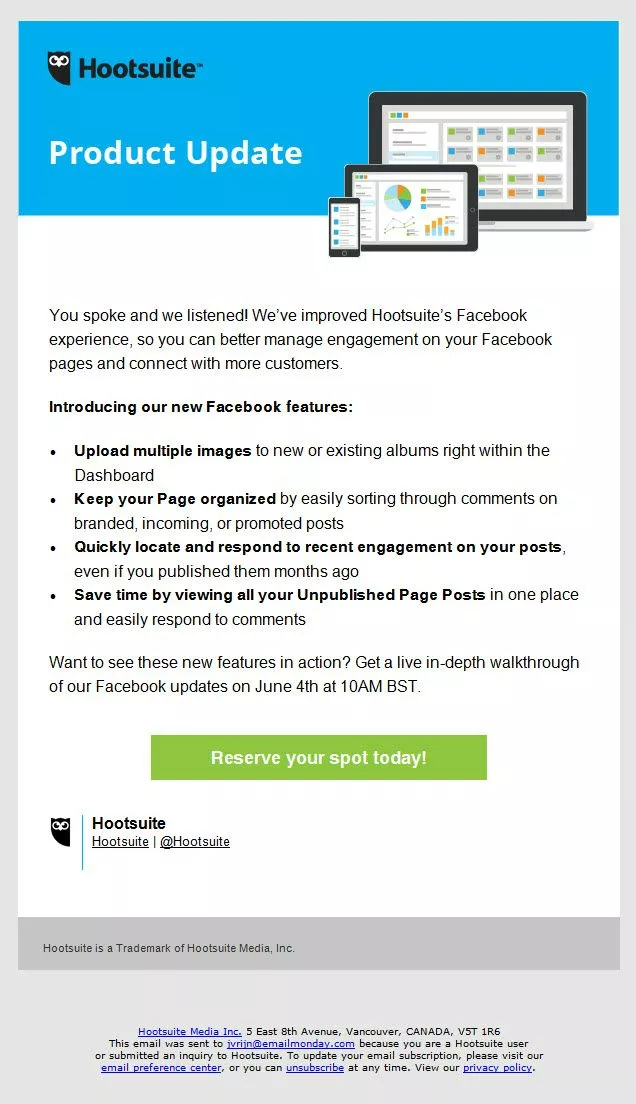
This personal approach enables you to address former customers’ issues with your SaaS directly and show that you value their feedback enough to integrate them into your services.
Best cancellation flow examples from SaaS companies
An effective cancellation process can provide an excellent customer experience, if not improve user retention. Let’s go over the cancellation flows that SaaS companies implement to retain customers.
1. Userpilot’s cancellation flow
Userpilot offers customer success teams tools to deliver personalized in-app experiences at different stages of a customer journey for maximum growth.
Here’s what our cancellation process looks like.
Multi-choice exit survey
Once customers decide to cancel the account, we use a simple survey to understand the reason why they’re canceling in the form of a multiple-choice question.

2. Slack’s cancellation flow
Slack is among the market’s most popular online team communications and collaboration tools.
While the free version is more than enough for most businesses, their paid solutions offer better storage, integrations, and voice calls for those who need them.
Here’s how this SaaS company approaches its cancellation flow.
The Overview page provided information about their current plan and how customers can keep the current price and not pay for the increased cost, with a Price lock-in offer before canceling.
To encourage users to take action on their accounts, Slack indicated the date when the lock-in price offer would expire. This gives them enough time to decide and secure their account before the deadline.
On the next page, Slack shows you a preview of the plan changes, depending on your action.
It covers everything you must know about your plan moving forward, although they could have made it shorter for brevity.
Exit survey with no alternatives
Slack launches an exit survey asking users to share feedback and explain why they’re upgrading or downgrading plans in a multiple-choice question.
But Slack decided not to offer alternatives based on their actions. Doing so puts users on a one-track mind to push through with their decision.
3. Asana’s cancellation flow example
One of the best project management tools, Asana, is a wise choice for agile businesses due to its reasonable pricing for plans chock full of useful features and integrations.
At the same time, it has a clean and simple cancellation flow that you can replicate in your SaaS business.
Cancellation reason form
Asana takes the Slack route by presenting multiple choices for customers to choose from, explaining to the company why they’re leaving.
Are you starting to notice a pattern here?
It’s as simple as a user feedback survey would come. Customers can click on the reason that best applies to them and press “Continue.”
Personalized alternative
The next step of the cancellation flow is where Asana presents its counter-offer.
Based on your plan and usage, it will suggest you upgrade or downgrade your account.
In the example above, Asana took the number of seats you’re using in your current plan into consideration for this personalized offer.
By directly addressing areas in a customer’s account that remain underused, they can present an alternative offer to reduce the customer churn rate.
More importantly, the page isn’t busy with other irrelevant information, making the personalized alternative shine through. It allows customers to see the advantage of staying with Asana instead of unsubscribing.
4. Mailchimp’s cancellation flow example
One of the most popular email marketing platforms for years, Mailchimp continues to provide everything businesses need to promote and make sales from their brand via email automation and customer segmentation.
As good as its features and solutions are, its cancellation flow qualifies as a good example of proper offboarding.
Pause option
Before allowing customers to cancel their accounts, Mailchimp loads a page giving them an option to pause their billing cycle, or permanently delete their accounts.
What’s interesting in this approach is the warning, “Only paid monthly accounts can pause.” That means annual subscribers will lose their data once they cancel their accounts.
Even if you’re on a monthly subscription, this warning shows you the gravity of the situation should you decide to cancel your account.
Mailchimp designed this landing page to make subscribers think twice about whether to go through with the cancellation and bear with the consequences.
Long-form exit survey
The next step customers must take before canceling their accounts is to participate in a comprehensive exit survey.
The survey consists of four questions, two of which are multiple choice questions while the other half are open questions.
However, having more than a question in your survey that isn’t a multiple choice may cause customers to skip the survey altogether.
If you plan on designing your exit survey similar to Mailchimp, monitor its performance for a few months. If the engagement rate is lower than expected, consider decreasing the questions to improve it.
5. Zoom’s cancellation flow
Zoom is now synonymous with online video communications, especially since companies have transitioned to a remote setup these past few years.
Below are the steps Zoom takes in its cancellation flow:
Feedback survey popup
A popup appears whenever you click on the cancel button before canceling your account. It asks for user feedback regarding why you wish to unsubscribe.
The advantage of using a popup to feature a microsurvey like this is that loading the survey is much faster than loading it on a brand-new page.
Also, you can set the popups to blur or darken the surrounding area, so all eyes are on the survey, thus increasing engagement.
Offer an alternative
After answering the short survey, Zoom will present a counter-offer to keep customers from unsubscribing.
It’s not a personalized offer compared to Asana’s. But it’s a much lower offer than the customer’s current subscription, which is still a valiant attempt at keeping them.
6. Mixpanel’s cancellation flow
Mixpanel should be familiar with cancellation flows since this SaaS tool helps businesses increase conversions and retention.
Below is their take on the cancellation process:
Exit survey
The first cancellation survey and flow begins with a survey asking people why they’re unsubscribing, what they plan on doing with their analytics, and other details they want to share with the company.
After submitting the survey, Mixpanel cancels the account and deletes customer data. There’s no attempt to offer an option or incentive to keep customers from leaving.
It’s not the ideal flow, but Mixpanel can use this data to improve the experience of future users.
How to build a cancellation flow without having to code
You’re not wrong to think that creating in-app surveys can be difficult. But Userpilot makes designing them quickly by following this three-step process:
Build an exit survey
Use an in-app survey and just simply indicate the common reasons why your customers leave based on research.
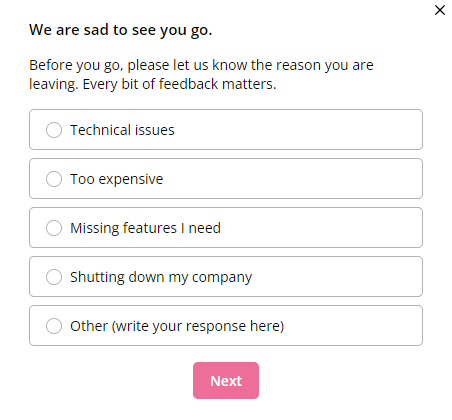
Ideally, you want to include “Other” as one of the choices. Upon clicking on it, a text field should appear where customers can type in the reason not mentioned in the list.
You can set triggers and show your survey when users click “Unsubscribe”

Create custom segments for each response
The beauty of Userpilot’s in-app surveys is the ability to organize customers into segments based on their behavior.
The goal is to group users that share the same user attributes.
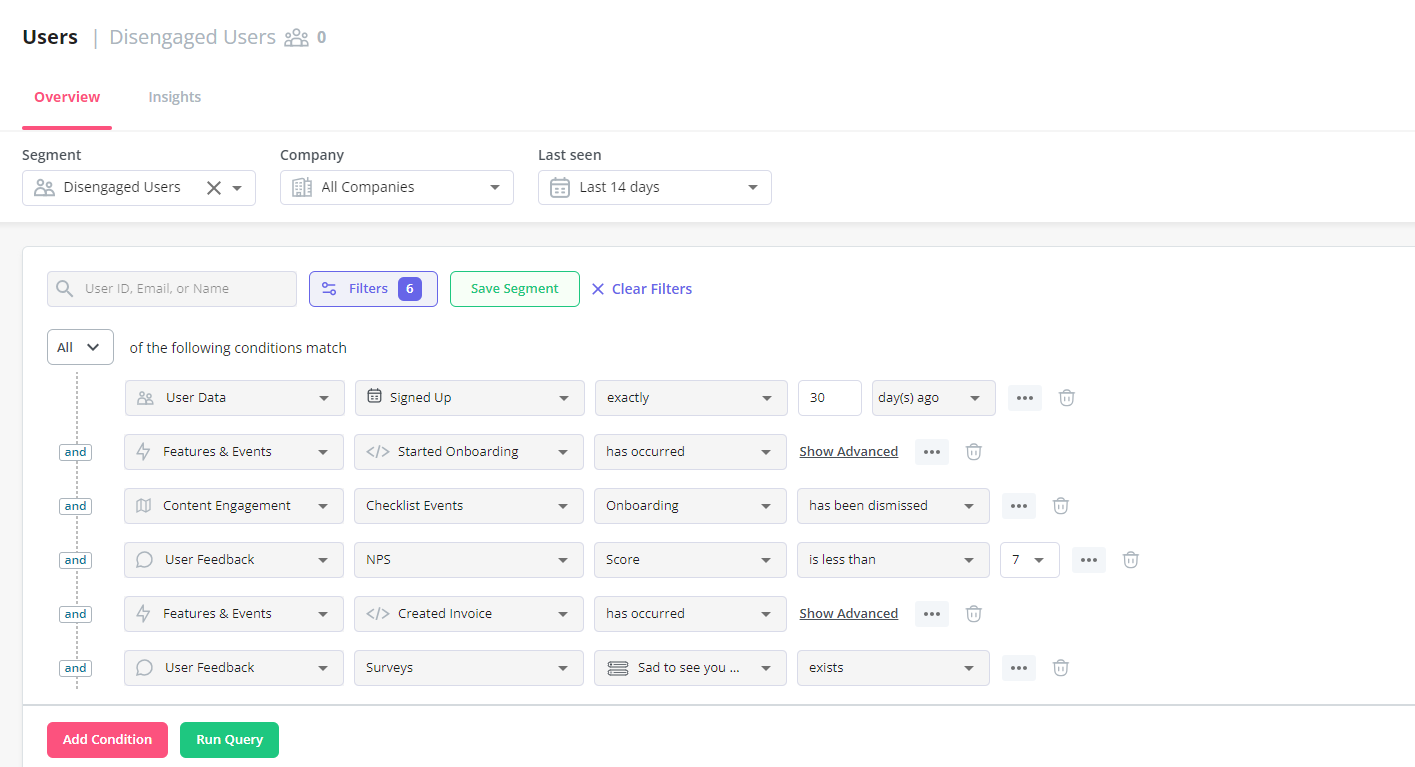
These attributes include clicking the ” cancellation page” button, engaging with your survey, and typing a response in your cancellation form.
These attributes also express the desire of customers to unsubscribe from your SaaS tool. In this case, you need to group them in the same segment together.
From here, only people in this segment can receive a specific alternative offer.
Set up personalized alternatives for each segment
It’s possible to have multiple segments of customers looking to cancel their accounts.
To keep them from leaving, you must propose downgrading their accounts or a custom solution to accommodate their needs better.
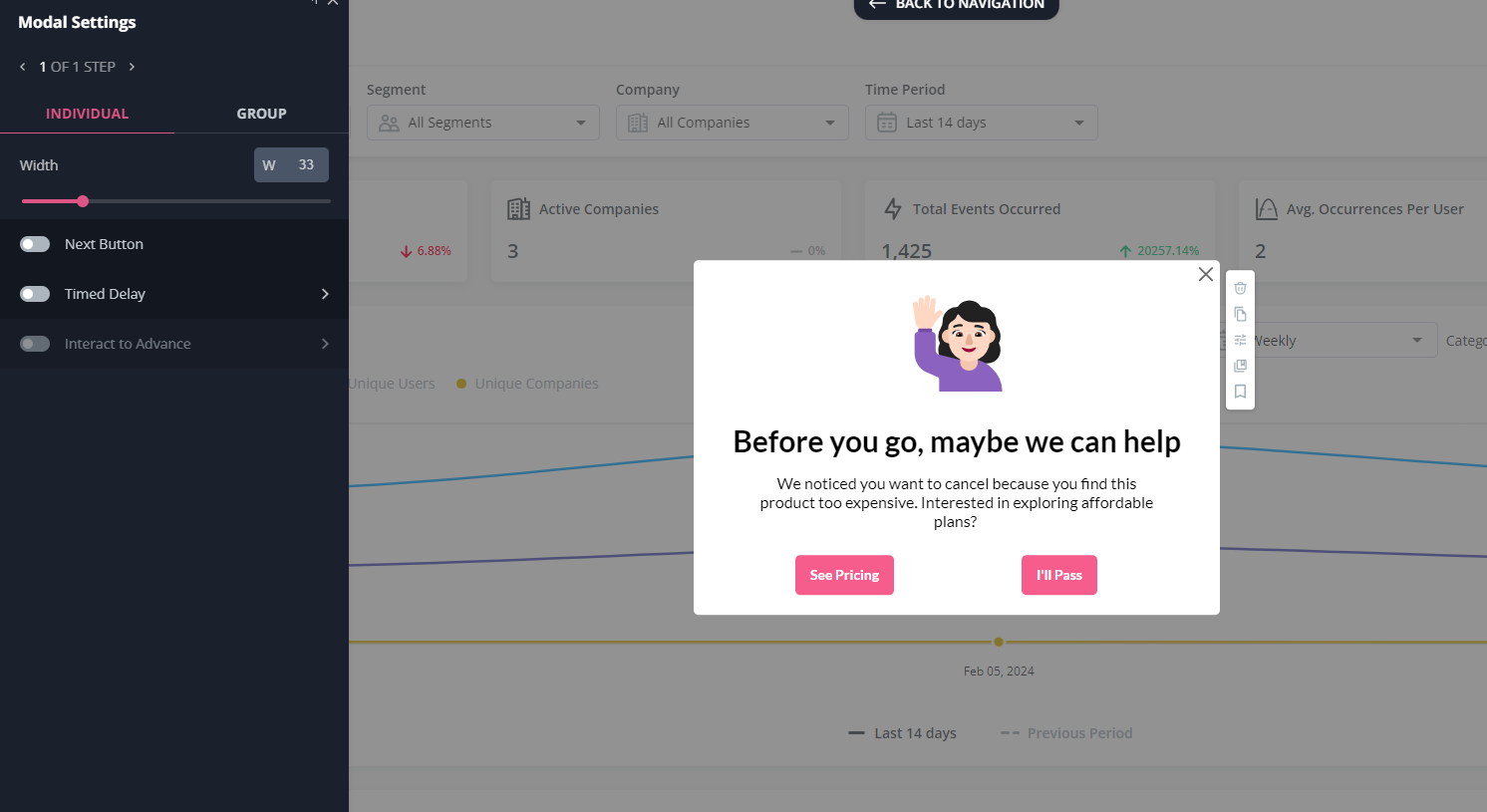
Offering more features and the correct plan for each segment helps you increase conversions and get more people to stay.
Use the survey responses to reduce future churn
Solve the issues users mentioned and implement the recommendations to improve your product quality.
This will enable you to meet user expectations better and reduce churn among existing customers.
Conclusion
Knowing how to create your cancellation flow from the examples above encourages them to stay as customers.
You also make customers experience respect and appreciation even after leaving, paving the way for them to try your business again soon.
Have these cancelation flow examples inspired you? Get a Userpilot Demo and see how you can design the steps in your cancellation process to be optimized for increasing engagement and reducing churn.















